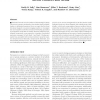Free Online Productivity Tools
i2Speak
i2Symbol
i2OCR
iTex2Img
iWeb2Print
iWeb2Shot
i2Type
iPdf2Split
iPdf2Merge
i2Bopomofo
i2Arabic
i2Style
i2Image
i2PDF
iLatex2Rtf
Sci2ools
JOCN
2010
2010
The Neural Correlates of Persuasion: A Common Network across Cultures and Media
■ Persuasion is at the root of countless social exchanges in which one person or group is motivated to have another share its beliefs, desires, or behavioral intentions. Here, we report the first three functional magnetic resonance imaging studies to investigate the neurocognitive networks associated with feeling persuaded by an argument. In the first two studies, American and Korean participants, respectively, were exposed to a number of text-based persuasive messages. In both Study 1 and Study 2, feeling persuaded was associated with increased activity in posterior superior temporal sulcus bilaterally, temporal pole bilaterally, and dorsomedial prefrontal cortex. The findings suggest a discrete set of underlying mechanisms in the moment that the persuasion process occurs, and are strengthened by the fact that the results replicated across two diverse linguistic and cultural groups. Additionally, a third study using region-of-interest analyses demonstrated that neural activity in t...
| Added | 28 Jan 2011 |
| Updated | 28 Jan 2011 |
| Type | Journal |
| Year | 2010 |
| Where | JOCN |
| Authors | Emily B. Falk, Lian Rameson, Elliot T. Berkman, Betty Liao, Yoona Kang, Tristen K. Inagaki, Matthew D. Lieberman |
Comments (0)

